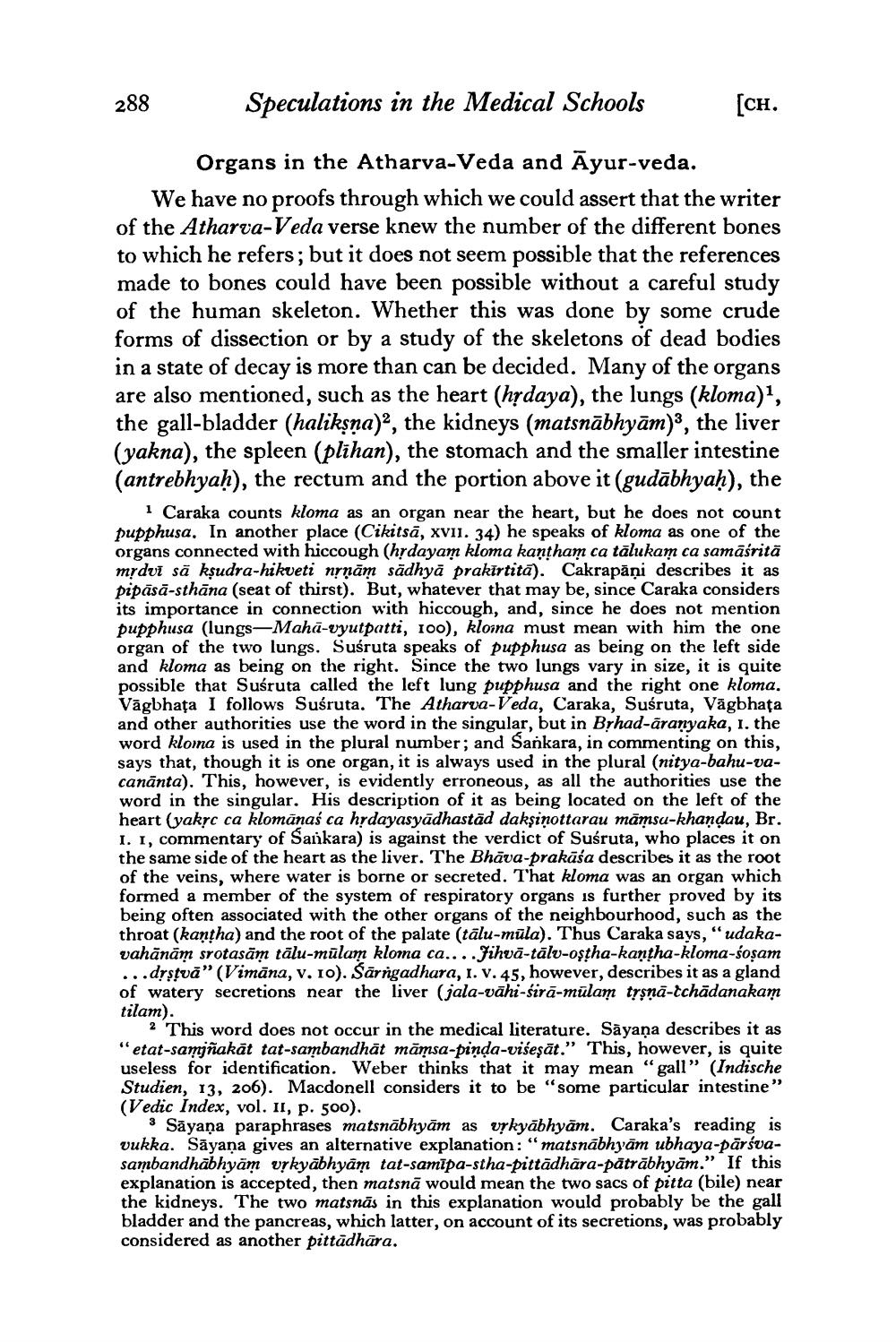________________
288
Speculations in the Medical Schools
[ch.
Organs in the Atharva-Veda and Āyur-veda. We have no proofs through which we could assert that the writer of the Atharva-Veda verse knew the number of the different bones to which he refers; but it does not seem possible that the references made to bones could have been possible without a careful study of the human skeleton. Whether this was done by some crude forms of dissection or by a study of the skeletons of dead bodies in a state of decay is more than can be decided. Many of the organs are also mentioned, such as the heart (hrdaya), the lungs (kloma)', the gall-bladder (haliksna), the kidneys (matsnābhyām), the liver (yakna), the spleen (plihan), the stomach and the smaller intestine (antrebhyaḥ), the rectum and the portion above it (gudābhyaḥ), the
i Caraka counts kloma as an organ near the heart, but he does not count pupphusa. In another place (Cikitsā, xvII. 34) he speaks of kloma as one of the organs connected with hiccough (hrdayam kloma kantham ca tālukam ca samāśritā mrdui sā kņudra-hikueti nrņām sādhyā prakirtita). Cakrapāņi describes it as pipāsā-sthāna (seat of thirst). But, whatever that may be, since Caraka considers its importance in connection with hiccough, and, since he does not mention pupphusa (lungs-Mahā-vyutpatti, 100), kloma must mean with him the one organ of the two lungs. Suśruta speaks of pupphusa as being on the left side and kloma as being on the right. Since the two lungs vary in size, it is quite possible that Susruta called the left lung pupphusa and the right one kloma. Vāgbhața I follows Susruta. The Atharva-Veda, Caraka, Susruta, Vägbhata and other authorities use the word in the singular, but in Brhad-aranyaka, 1. the word kloma is used in the plural number, and Sankara, in commenting on this, says that, though it is one organ, it is always used in the plural (nitya-bahu-vacanānta). This, however, is evidently erroneous, as all the authorities use the word in the singular. His description of it as being located on the left of the heart (yaksc ca klomānaś ca hrdayasyādhastād dakşiņottarau māmsu-khandau, Br. I. I, commentary of Sankara) is against the verdict of Susruta, who places it on the same side of the heart as the liver. The Bhāva-prakāśa describes it as the root of the veins, where water is borne or secreted. That kloma was an organ which formed a member of the system of respiratory organs is further proved by its being often associated with the other organs of the neighbourhood, such as the throat (kantha) and the root of the palate (tālu-müla). Thus Caraka says, "udakavahānām srotasām tālu-mūlam kloma ca...Jihvā-tālv-oştha-kantha-kloma-sosam ...drstvā” (Vimāna, v. 10). Sārngadhara, I. V.45, however, describes it as a gland of watery secretions near the liver (jala-vāhi-sirā-mulam trsna-tchādanakam tilam).
2 This word does not occur in the medical literature. Sāyaṇa describes it as "etat-samjñakāt tat-sambandhāt māmsa-pinda-višeşāt." This, however, is quite useless for identification. Weber thinks that it may mean "gall” (Indische Studien, 13, 206). Macdonell considers it to be "some particular intestine" (Vedic Index, vol. II, p. 500).
* Sāyaṇa paraphrases matsnābhyām as vrkyābhyām. Caraka's reading is vukka. Sāyaṇa gives an alternative explanation: "matsnabhyām ubhaya-pārsvasambandhābhyām vrkyābhyām tat-samīpa-stha-pittādhāra-pātrābhyām.” If this explanation is accepted, then matsnā would mean the two sacs of pitta (bile) near the kidneys. The two matsnās in this explanation would probably be the gall bladder and the pancreas, which latter, on account of its secretions, was probably considered as another pittādhāra.




